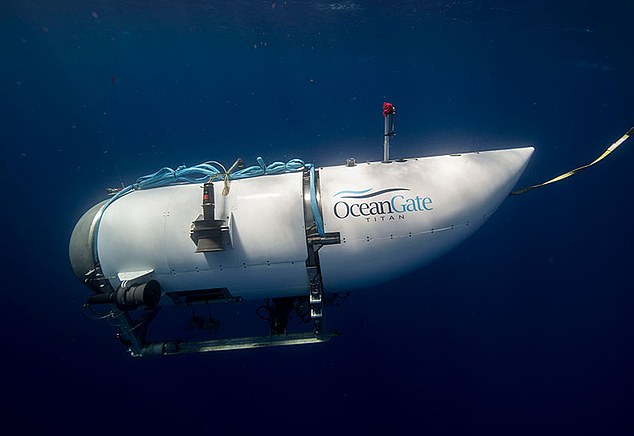A transcript purportedly detailing communications between those aboard the submersible Titan and its mother ship, as it descended toward the wreckage of the Titanic last June, has been revealed to be completely false.
The communications log had already raised eyebrows when it was published last summer, as it documented a series of alarming events that turned a dive to the bottom of the Atlantic into a desperate fight for survival.
This diary served to document the futile efforts of the five travelers to return to the surface.
But the head of the US federal investigation team has now declared that the transcript is completely fictitious.
After nearly a year of exhaustive investigation, the team found no evidence indicating that the Titan’s occupants had any warning of the catastrophic implosion that was about to occur and ultimately claimed their lives.
US federal investigators have debunked a widely circulated transcript that purportedly details communications between the Titan submersible and its mother ship.
At the immense depths of two miles below the surface where the incident occurred, the pressures would have caused the submersible’s hull to collapse instantly.
‘I’m sure it’s a fake transcript. It was made up,” said Capt. Jason D. Neubauer, a retired U.S. Coast Guard officer and chairman of the Marine Board of Investigation. It is unclear who the original source of the fake document was.
The fake transcript, which emerged in late June, detailed alleged minute-by-minute communications filled with technical jargon and realistic descriptions, including Titan-unique acronyms that gave it an air of authenticity.
It suggested that the Titan’s crew was in a state of panic, dealing with hull alarms and crackling noises before communications abruptly ceased.
The transcription focused on the RTM or real-time helmet condition monitoring system.

‘I’m sure it’s a fake transcript. It was made up,” said Capt. Jason D. Neubauer, a retired U.S. Coast Guard officer and chairman of the Marine Board of Investigation. It is unclear who the original source of the fake document was.
The OceanGate firm described the system as having “an unparalleled safety feature that evaluates the integrity of the hull on every dive,” which would warn of any problems.
In one part of the Titan transcript the mothership was informed of various hull alarms along with crackling noises.
A message nearing the end of the fake communications referred to the sensor and read: “RTM alert active, all red.”
But the fake transcript ended in silence as the mothership sent seven messages inquiring about its destination.
The alleged last message read: “Please respond if you can.”
“Someone did it well enough to make it seem plausible,” Neubauer said, and the record made the adventurers “look like they were panicking.”
Dr. Alfred S. McLaren, a retired Navy submariner and submersible pilot, initially found the transcript plausible, but later speculated that it might have been fabricated to discredit OceanGate or distress the victims’ families.
“It may have been done to embarrass OceanGate,” he told the The New York City Times. “It was certainly guaranteed to agitate the relatives.”

The transcript, viewed millions of times online, falsely suggested that the crew was aware of their impending doom before the submersible’s catastrophic implosion. In the photo, the remains of the Titan submersible are recovered from the ocean last June.
Despite its compelling appearance detailing back-and-forth communications between the submarine and the mother ship, the federal team identified several discrepancies.
Crucially, they had access to records of actual communications between the Titan and its mothership, which remain confidential.
Official records seen by the National Transportation Safety Board revealed no evidence that the crew was aware of their impending fate.
Neubauer hopes the truth can offer some comfort to the victims’ families and ease the worries their loved ones suffered in their final moments.
“It doesn’t make it any less painful, but it can help,” he told New York Times.

A view of the ship Horizon Arctic, as recovered parts of OceanGate Expeditions’ Titan submersible are returned
The revelations about the fake transcripts are the first to emerge from an extensive investigation that began last summer.
While there were hopes of concluding the investigation before the one-year anniversary of the Titan’s loss, a final report could take years.
Neubauer highlighted the complexities of the investigation, including a lack of witnesses, new vessel technologies and jurisdictional challenges due to the disaster in international waters.
The investigation involves multiple international partners and U.S. Navy assistance in debris recovery.
Although the initial goal was to complete the report within a year, Neubauer indicated it would likely take two to three years, a typical time frame for such extensive investigations.
He stressed that despite the long process, the findings can lead to new safety standards, which could provide some comfort to the families of the victims, knowing that their tragedy could help prevent future disasters.

The five men aboard the submersible were above left: Hamish Harding, 58, a British airline executive; top right Stockton Rush, 61, founder and CEO of OceanGate; bottom left Paul-Henri Nargeolet, 77, a French Titanic expert and bottom right Shahzada Dawood, 48, a British Pakistani businessman; his son, Suleman, 19
The five men aboard the submersible were Shahzada Dawood, 48, a British Pakistani businessman; his son, Suleman, 19; Hamish Harding, 58, a British airline executive; Paul-Henri Nargeolet, 77, a French expert on the Titanic and Stockton Rush, 61, founder and CEO of OceanGate, the American company that built the submersible and conducted the dives for tourists. He was also piloting the Titan on the day of the tragedy.
Rush, who piloted the Titan, had previously dismissed concerns that the submarine’s experimental design was destined to fail.
Despite being considered an “experimental” ship, it submerged beneath the waves a total of 90 times and reached the depths of the Titanic on 13 occasions.
The Titan disappeared on June 18, 2023, and debris was found near the wreckage of Titanic in the North Atlantic five days later, tragically confirming that a catastrophic implosion had occurred.
During the search, there were brief hopes that the people on board might still be alive, generated by reports of underwater noises and discussions about the submarine’s remaining oxygen.
This led to a fleet of international ships coming to search for the missing submarine.
On June 22, five days later, the Coast Guard confirmed its worst fears after debris from the Titan was discovered and the submarine imploded.


